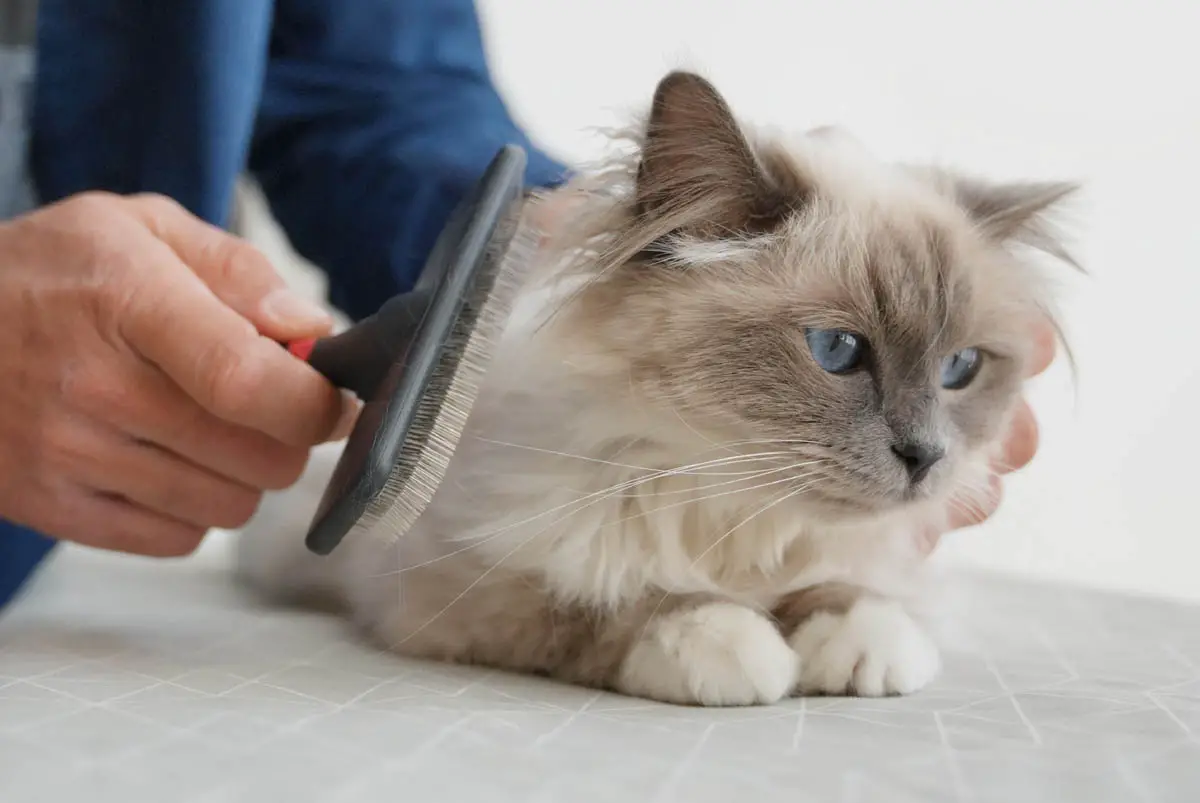Birman Cat Grooming (Easy Step-by-Step Guide)
Birman cats have medium to long silky hair paired with beautiful blue eyes, which gives them their elegance.
Grooming is best started when your Birman is still a kitten, as they will adapt to the process. Older cats are less adaptable and will likely resist your attempts to perform the grooming steps.
Birmans are not hypoallergenic cats, so grooming them correctly will help reduce fur clumps around your house. Grooming will also improve your cat’s quality of life by keeping them healthy and preventing common problems.

One of the best things about grooming your Birman from an early age is that it helps develop a deep bond between you and your cat, and they will grow to love that special time with you each week.
What Kind of Coat Does a Birman Cat Have?
Birman cats have silky smooth medium to long, single-coat fur, which is generally tangle and mat-free.
They do not shed a lot compared to many other long-haired cats, but do shed more during spring as the weather warms up.
However, this doesn’t mean that you should skimp on brushing your cat’s coat during colder months, as it helps reduce the occurrence of matting due to debris lodging in their fur.
How Often Should Your Groom A Birman Cat?
Most times of the year you should groom your cat two or three times per week, but during spring it’s best to groom your Birman every day because of their heavier shedding.
Additionally, although your cat self-grooms you still need to bathe them occasionally. The National Cat Groomers recommend bathing your cat every 4-6 weeks.
As for their claws, make a habit of trimming your cat’s nails every 10-14 days. Having a nail clipping routine makes it easier and keeps it under control as your cat gets used to the process.
When it comes to brushing their teeth, it’s recommended you do it at least three times a week, but if your schedule allows – it’s best to brush their teeth every day.
Cat Grooming Supplies You Will Need
Time to prepare your grooming kit. These items aren’t too expensive – but don’t go too cheap on the nail clippers, as a better-quality pair can make the job much easier.
Here are the supplies you will need.
- Bristle brush or Comb (with 7/8” long teeth).
- Flea comb.
- Nail clippers.
- Fine toothbrush.
- Pet wipes or Facecloth.
- Cotton gauze pad.
- Ear cleaning solution.
- Eye-safe pet Shampoo (or flea shampoo).
- Lukewarm Water (72°F).
- A flexible small shower sprayer.
- Some old towels.
- A 20×16-inch tub.
The comb or brush you choose should NOT have sharp-ended teeth. A stainless-steel brush with rubber-tipped ends is a good choice, as it does not develop static electricity.
How To Groom Your Birman Cat (In 5 Steps)
Let’s get down to it and look at the specific steps to groom your fluffy friend, with tips on the best way to get the job done.
1. Grooming a Birman Cat’s Coat
This part should be easy because cats love to have their body stroked.
Since grooming is a form of touch, you need to know where your cat enjoys being touched, and which areas may require some caution.
You want to groom your cat when they’re relaxed and happy – so if they’re in a bad mood, give them some treats to cheer them up first!
Once your cat is relaxed, hold the brush out to them and let them rub or sniff it to make its scent familiar to them.
Take advantage of the fact that cats enjoy being stroked on their face. Begin grooming by brushing or combing your Birman cat on the face, then to their neck, and finally to their back.
Be careful when brushing their tummy area as it’s sensitive and they don’t like it touched.
When brushing your cat’s fur, do it in the direction their hair grows.
The grooming time should be as long or as short as your cat is comfortable with, they will let you know when they have had enough.
SECRET TIP!
If your Birman is shedding heavily in spring, wet your hands slightly and comb your cat’s coat with your fingers. This will drag out lots of shedding fur as your damp fingers grip the hair like a cat’s tongue (and your cat will love it too!).
Look carefully for parasites like fleas while brushing, and switch to using the fleas comb to remove them if necessary.
2. Clipping Your Birman’s Claws
This is possibly the hardest part of the grooming process. However, it’s still very doable.
Try to make the clipping session as short as possible to prevent stressing your cat. If you stress them, it will just be more difficult next time. Generally, clipping their front claws is enough.
Start by setting the mood – hold your cat on your lap or chest and give them a small treat to relax them.
Another good method is to have one person hold your cat, while the other clips their claws. Sitting outside in a chair helps keep the cat busy, and less aware of the clippers.
- Lift one of their front legs so that the lower part of their leg rests in your upturned palm.
- Choose one nail to start with, applying a little pressure on their paw pad to extend the nail.
- Using your other hand – place your forefinger on your cat’s paw pad and your thumb on top of the toe.
- Squeeze the nail gently to note where the quick is (the visible pink vein in the nail).
- Cut the nail at a 45-degree angle as it allows the nail to rest comfortably on the ground when walking. Avoid cutting the quick or you will cause your cat pain, and the nail will bleed.
Use firm pressure when cutting the nail otherwise the nail will just crush instead of cutting it cleanly.
Remember to stop if your cat starts growling, twitching, or panting, as it may be a sign that they’re hurt or angry which may prompt them to bite you.
3. Cleaning Their Ears
It may take time to get your Birman cat to enjoy having their ears cleaned but with the right tools, gentleness, and patience, you’ll get there.
Start by comfortably placing your cat on your lap. Next, gently flip their ear tips, and flood their ear canal with the solution (don’t worry if some of it spills out).
Use the cotton gauze pads to massage the base of your cat’s ear gently, allowing them to shake and get rid of the excess solution.
Lastly, wrap a dry gauze around your finger and wipe any debris in the ear canal (don’t probe deeper in the ear canal than the eye can see).
4. Brushing Their Teeth
When brushing your cat’s teeth, your goal should be to eliminate any food or bacteria in their teeth and the gumline.
You can use a gauze wrapped on your finger, but it’s advisable to use an animal toothbrush.
There is no need to use toothpaste when brushing your cat’s teeth as toothpaste mostly helps with the prevention of cavities, which isn’t a concern for cats.
If you really must use toothpaste, make sure it’s a veterinary product.
To brush your Birman cat’s teeth, brush their teeth in a circular motion and pay more attention to their gum line.
Your cat may not be very cooperative at first, so ensure you’re gentle to calm them down.
If your cat refuses to let you brush its teeth stop and try again another day.
Some cats simply won’t let you brush their teeth. In this case, ask your vet to do it when getting a health check-up done.
5. Bathing Your Birman
Bathing cats is notoriously difficult with most breeds, and if you don’t start when they are a kitten you may suffer life-threatening injuries trying to wash an adult Birman cat!
TIP
Clip your cat’s claws before bathing them – it may just save your life.
Ensure towels are laid out ready to place your wet cat on.
- First start by wetting a facecloth with lukewarm water, and gently clean around your Birman’s eyes and face. If your cat is dirty, then put a little shampoo in the water, and stir with the washcloth before cleaning their face.
- Next, you’ll have to brave up and drop your ballistic fluffball into the tub of water. Don’t hesitate here – make it quick.
- If your Birman has fleas, then wet its neck quickly at this point and lather-in flea shampoo around its neck to prevent the fleas from escaping to your cat’s dry head.
- Now working with the facecloth and soapy water work your way around your cat until their fur is well soaked and washed.
- Next rinse the soap out with warm water from the shower hose.
- Use your hands to remove as much water as possible from their coat and tail by running your hands along their body and tail.
- Once done, place your cat on the dry towels, starting by blotting the water from their coat. Then wrap a towel around them and dry as much as possible.
- You can choose to let them air dry from this point, however they may look a bit scraggly, so you can choose to use a hairdryer to get a better-looking result.
Your Birman will likely hate a hairdryer as much as a bath, so it is a good idea to get your cat used to it beforehand.
This may take a few weeks of having them around while you dry your own hair or having it nearby at low speed while they eat.
What Problems Can Grooming Prevent | Why Groom Your Cat?
You can avoid many health issues by regularly grooming your Birman cat, let’s take a look at a few common ones.
Excessive Shedding
As a cat parent, you know they somehow find a way to deposit their hair on your couch, bed, carpet, and everything else in your home!
Regular brushing and combing help reduce shedding and the amount of fur in your house.
Matted Hair
Regular brushing and combing can help prevent matting, which can lead to many issues if not fixed for a long time.
Matting reduces the ability of your cat to produce natural oils that keep their skin and coat healthy, causing their coat to become dull and brittle.
If matting is left to an advanced stage, it can cause tears in your cat’s skin causing bleeding, and the chance of infection.
Excessive Hair Ingestion
Even if your cat doesn’t have issues with hairballs, letting them swallow more of their hair doesn’t do them any good.
Brushing helps to reduce the amount of shedding fur, preventing your cat from swallowing it while self-grooming.
This is particularly important for older cats with a less active gut, making it harder for them to move hairballs through their system.
If you don’t enjoy cleaning up vomit due to hairballs, then regular grooming is a must!
Damage From Sharp Claws
Leaving your cat’s claws unattended can cause them to become long and dangerous as they tend to use them as their little weapons.
Cutting your cat’s nails prevents them from hurting themselves, other pets, and your family – especially kids.
Cats naturally scratch to sharpen their claws, so clipping them also prevents damage to furniture, carpets, and curtains.
Build Up of Skin Parasites
When flea and tick bites are left untreated, they can cause serious health problems to your cat.
Spotting the parasites in your cat’s thick coat can be hard, and the only time you can see the parasites is when grooming your cat.
This allows you to get rid of the parasites before it’s too late and helps stop them from infesting your home.
Birman Cat Grooming Benefits
There are many benefits that come with grooming your cat – the biggest one being increased snuggle and bonding time.
Grooming your cat also helps maintain your cat’s health and quality of life. It also helps with their appearance, and who doesn’t like a cute cat?
The best time to start grooming your Birman cat is when they’re young, but this isn’t possible if you rescue an adult cat. In this case, be patient and gentle with your cat until they get used to it.




